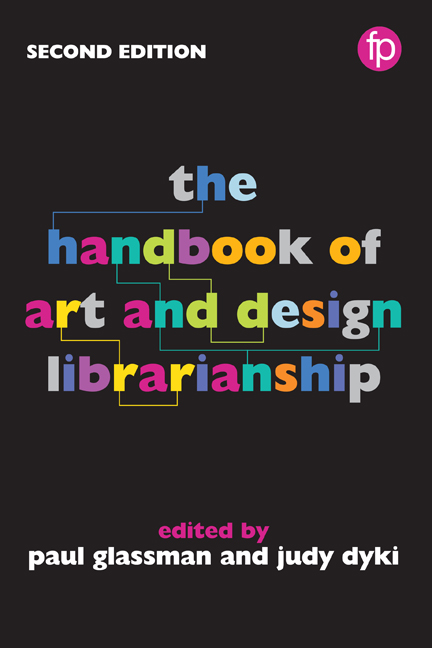Book contents
- Frontmatter
- Contents
- List of figures and tables
- Notes on contributors
- Foreword
- Preface
- Part I Roles and responsibilities
- Part II Materials and collection management
- Part III Teaching and learning
- Part IV Knowledge creation
- Part V The physical environment
- Part VI Promotion and sustainability
- 28 Marketing plans made simple
- 29 Engaging with social media
- 30 Website strategies for art and design libraries
- Appendix Library profiles
- Index
28 - Marketing plans made simple
from Part VI - Promotion and sustainability
Published online by Cambridge University Press: 08 June 2018
- Frontmatter
- Contents
- List of figures and tables
- Notes on contributors
- Foreword
- Preface
- Part I Roles and responsibilities
- Part II Materials and collection management
- Part III Teaching and learning
- Part IV Knowledge creation
- Part V The physical environment
- Part VI Promotion and sustainability
- 28 Marketing plans made simple
- 29 Engaging with social media
- 30 Website strategies for art and design libraries
- Appendix Library profiles
- Index
Summary
Why pursue a marketing plan?
Typically, definitions of marketing tell us what it is not: it is not advertising; it is not publicity; it is not outreach. But marketing does allow us to understand our audiences: our readers, our users, our constituents – however we refer to the people we hope to serve. And as we learn more about the people we hope to serve, we can communicate the value of academic libraries in a shared language. We can describe the benefit rather than the feature. For example, rather than boasting of the quality of cataloguing, we can offer the promise of finding what our patrons are looking for easily and quickly. Thus, a marketing plan is an exercise in showing empathy for our patrons. It is an opportunity to connect with users, to share the value of library services, and to tell a story that resonates. People take interest in propositions that relieve pain points and thereby make their lives easier. A marketing plan helps us intersect with our patrons’ needs. It helps us communicate value and evangelize.
Change management
With the cosmic changes the digital universe has brought to the place of libraries in the academic enterprise, adopting an entrepreneurial approach to change is essential for the successful organization, which adapts its core competencies to support innovation (Thota and Munir, 2011). And that innovation should centre on the expectations of users.
The most compelling reason to create a marketing plan is to help the library change, help it grow as an organism and ensure sustainability for the future. To envision change, we need first to understand the organization: its personality, culture and behaviour. In their theory of change management, Bolman and Deal established four frames – metaphorical lenses – through which organizations and their leaders picture themselves: structural, human resource, political and symbolic. The greater the number of frames through which an organization is viewed, the more comprehensive the understanding of its culture. Each ‘captures a vital slice of organizational reality’ (2014, 9):
• The structural frame highlights goals, strategy, roles and co-ordination. Structural leaders focus on co-ordination and implementation.
• The human resources frame centres on relationships, group dynamics, reactions to authority, resistance to the task and response to leadership (Green and Molenkamp, 2005).
- Type
- Chapter
- Information
- The Handbook of Art and Design Librarianship , pp. 297 - 304Publisher: FacetPrint publication year: 2017
- 1
- Cited by



